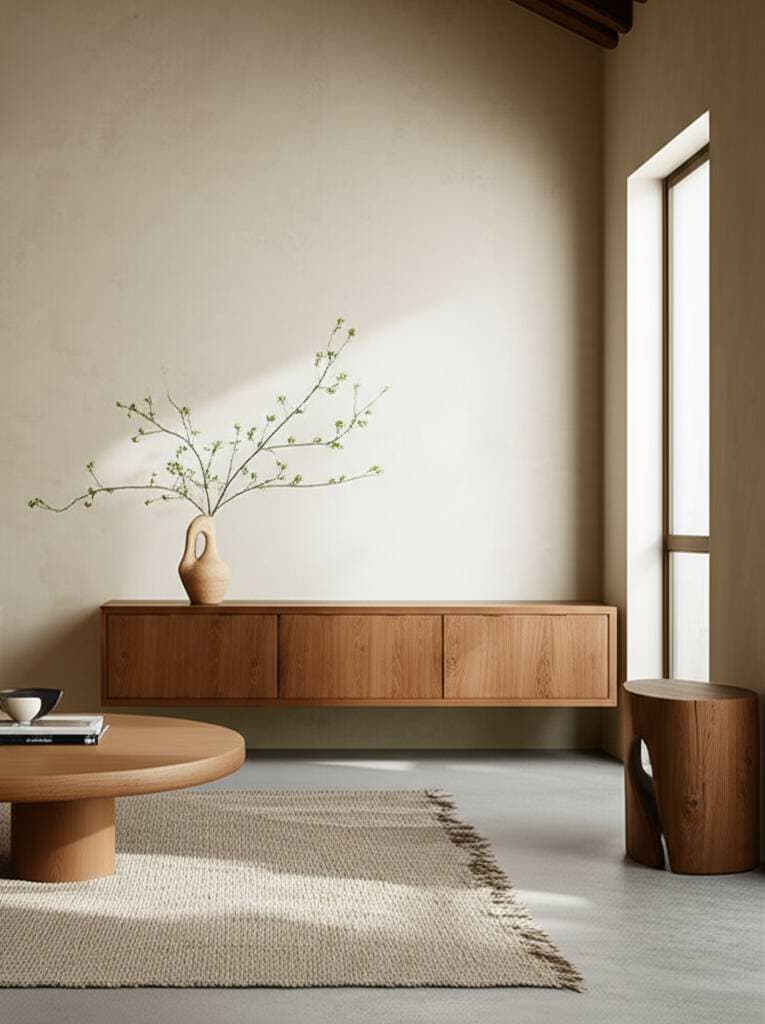Discover Beauty in Imperfection: Wabi-Sabi Design
Pristine interiors often appear too flawless, bordering on sterile. Furniture aligns precisely, surfaces shine without blemish, yet a vital element seems absent. If you yearn for environments that convey lived experience, tranquility, and genuineness, you align with the core of wabi-sabi design.
Seeing Beauty in the Real and Imperfect
Wabi-sabi represents a Japanese design philosophy that honors imperfection, impermanence, and simplicity. It prioritizes materials that mature naturally, surfaces bearing signs of use, and areas rooted in everyday existence. Rather than concealing defects, wabi-sabi elevates them as integral to an item's narrative.
This perspective shifts focus from polished exteriors and standardized production. A fractured ceramic bowl or a timeworn wooden table does not signify damage; it preserves a tangible chronicle of moments and interactions. Within a residence, this historical depth generates comfort and intimacy.
The Core Principles of Wabi-Sabi
Wabi-sabi design revolves around three interconnected concepts that define its character.
- Simplicity – Environments remain uncluttered and intentional. Retain solely items essential and cherished.
- Naturalness – Select materials derived from nature, preserving their inherent forms as much as feasible.
- Impermanence – All elements transform over time. Surfaces develop patina, hues soften, and these shifts enhance aesthetic value.
These tenets yield interiors that exude sincerity and repose. The aim extends beyond superficial style to cultivate a sense of relaxation and tolerance in one's surroundings.
Applying Wabi-Sabi in Your Home
Infusing wabi-sabi requires no complete renovation. Initiate modest changes and progress incrementally.
Choose natural materials.
Seek out wood, stone, clay, linen, or wool, allowing textures to remain evident. A rough-hewn oak surface or unbleached linen drapery imparts subtle refinement that deepens with age. Steer clear of varnishes or artificial overlays that mask the material's true essence.
Simplify your surroundings.
Curate each area to include only significant objects. One artisanal vessel upon a shelf surpasses a collection of uniform ornaments in impact. Wabi-sabi settings allow air and light to circulate freely, unhindered by excess.
Embrace wear and repair.
When an item fractures or fades, mend it with intention rather than replacement. The tradition of kintsugi employs gold or lacquer to restore ceramics, integrating the mending into the object's allure. Extend this practice to wooden legs or fabric edges in your furnishings.
Incorporate muted, earthy tones.
Opt for subdued grays, warm browns, soft greens, and creamy off-whites to establish a peaceful base. These colors echo the subtlety of soil, rock, and timber. They diffuse illumination softly, fostering an atmosphere of quietude.
Balance light and shadow.
Wabi-sabi favors daylight softened by plain fabrics or translucent screens reminiscent of shoji. Shadows contribute dimension and serenity rather than disruption. Select warm-toned lamps and diffused sources to maintain gentleness in the ambiance.
Costs and Practical Considerations
Wabi-sabi achieves accessibility through deliberate selection and ingenuity. Rather than purchasing contemporary pieces, restore vintage ones or acquire secondhand solid constructions. A salvaged oak dining surface typically ranges from $400 to $1,000, offering inherent character at a fraction of bespoke pricing.
Organic textiles such as linen or cotton fabric cost $30 to $80 per yard, scaled by craftsmanship. Artisan ceramics fluctuate in price, with a modest hand-thrown vessel priced at $25 to $60. Prioritize durable, meaningful acquisitions over abundance.
For refinishing tasks like paint removal to reveal bare grain, prioritize ventilation and use masks or respirators. Consult experts if older homes risk lead exposure or compromise integrity. Structural modifications seldom require permits, though verify regulations for electrical or wall adjustments with local authorities.
The Emotional Value of Imperfection
Wabi-sabi transcends aesthetics to reshape your bond with living spaces. It promotes mindfulness, attention to nuances, and embrace of the present state. An asymmetrical crafted cup or a surface marked by daily life underscores that allure arises from authenticity, not uniformity.
This philosophy alleviates pressure from perpetual renewal. Appreciation blooms for existing possessions, diminishing the urge for novelty. Such understated, flawed havens often welcome more profoundly than idealized showcases.
Blending Wabi-Sabi with Modern Living
Wabi-sabi adapts seamlessly to diverse architectures. In contemporary settings, combine minimalist hardware with distressed timber accents or irregular plaster finishes. For classic structures, streamline possessions and temper vibrant schemes with neutrals.
Experiment with material juxtapositions: polished concrete paired with hand-knotted mats, coarse vessels adjacent to brushed steel. These pairings accentuate the organic, crafted aspects central to wabi-sabi.
The philosophy aligns with eco-conscious practices. Investing in sparse, high-quality natural goods minimizes environmental impact while bolstering independent creators over industrial output.
Living with Wabi-Sabi Every Day
As you attune to charm in minor flaws, upkeep evolves from obligation to stewardship. Natural progression—settling particles, drying grains, softening weaves—infuses vitality into your domain.
Maintain simplicity in care routines. Employ gentle, plant-based solutions for organic elements, eschewing abrasives that accelerate decline. Address damages promptly yet patiently, allowing evolution to unfold.
Steps to Infuse Your Home with Wabi-Sabi
Tailor wabi-sabi not as imitation but as harmony with your rhythm. Begin by eliminating surplus that burdens the eye, then introduce tactile, grounding elements that soothe.
Authenticity supplants flawlessness, yielding residences enriched by each mark of passage. Wabi-sabi reveals elegance in flux, affirming that transformation enriches rather than diminishes.
